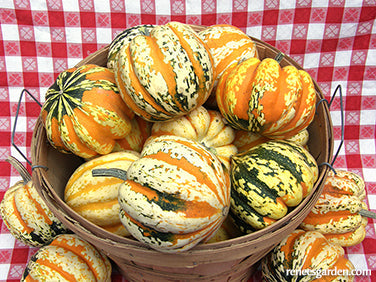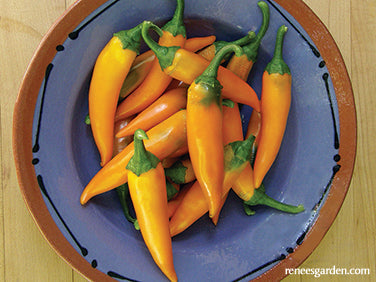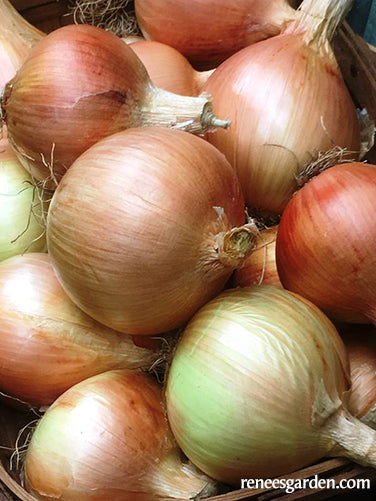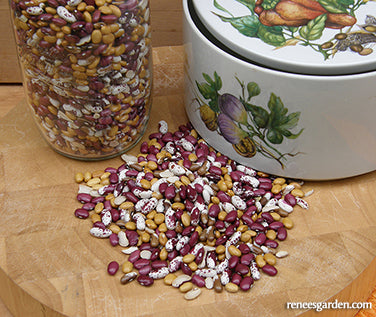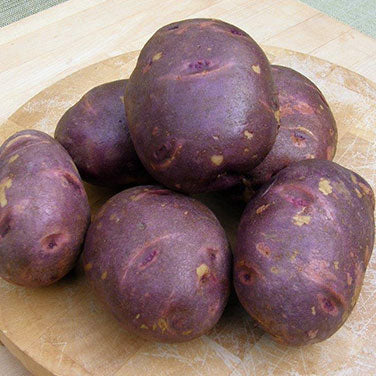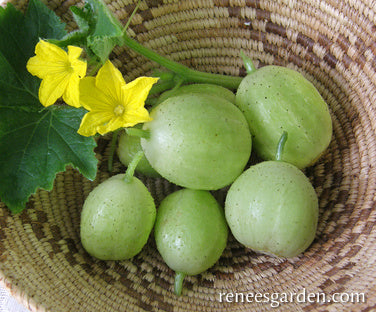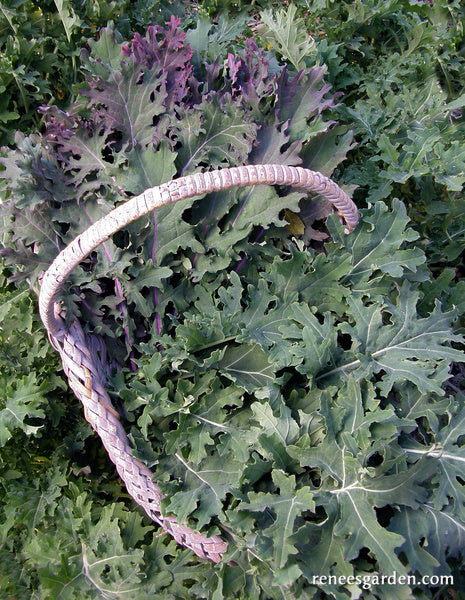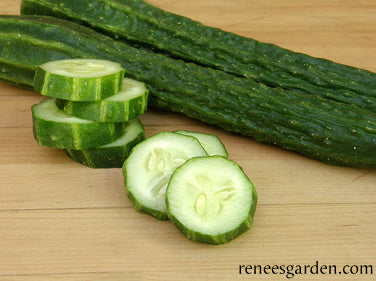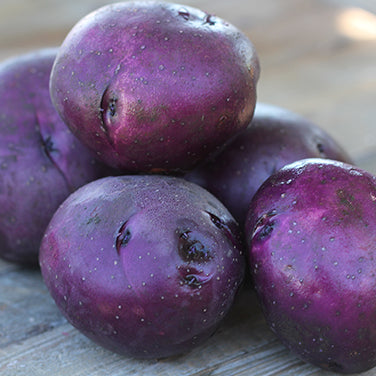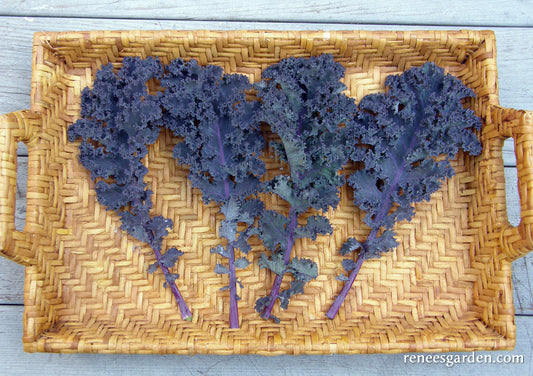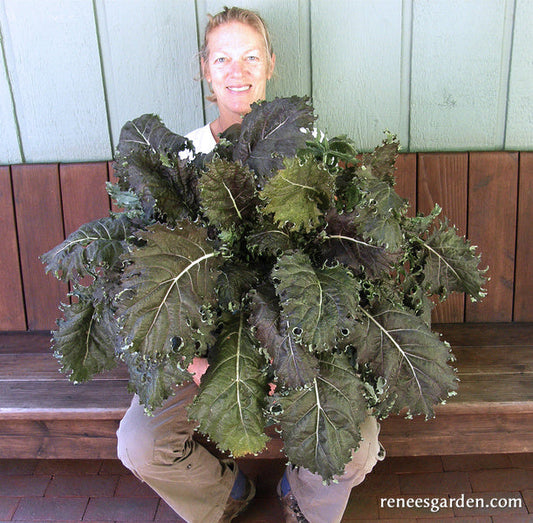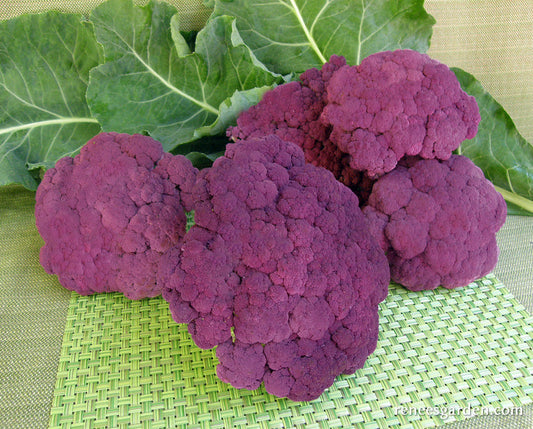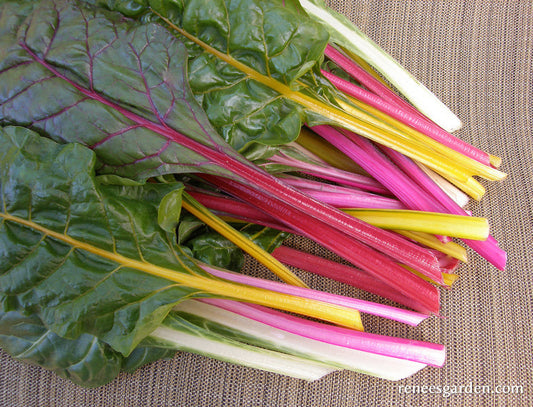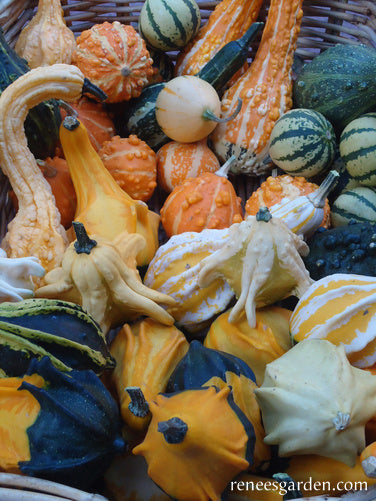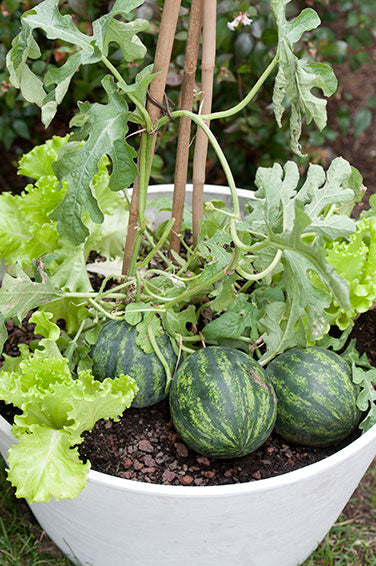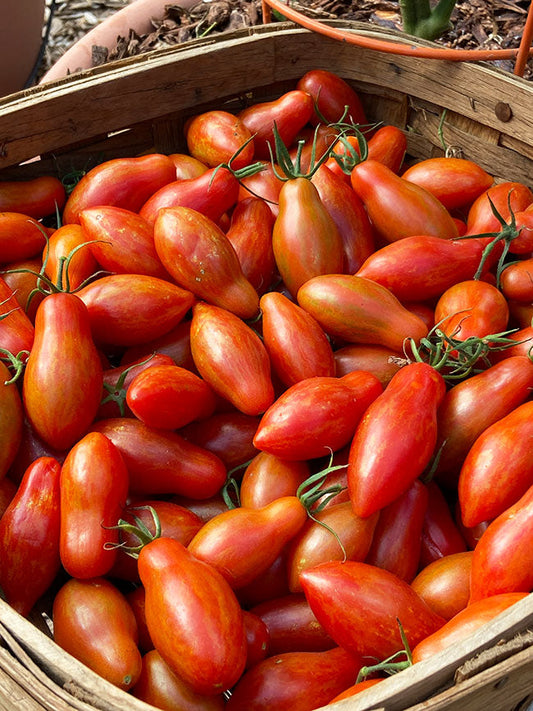Vegetables
Set The Table From Your Garden
-
Winter Squash Festival Acorn
BEST TO START OUTDOORS
Long keeping winter squash needs full sun, rich fertile soil and warm temperatures. Wait to plant until nights are reliably above 50°F (10°C) both day and night. Sow groups of 2 to 3 seeds 2 ft. apart and 1 in. deep in rows 4 ft. apart. Thin to 1 strong seedling per group to give plants ample room to grow. Or make slightly mounded hills 2 to 3 ft. across and 5 ft. apart and plant 4 to 5 seeds in each hill. When seedlings have several sets of leaves, thin to the strongest 3 seedlings per hill.
GROWING NOTES
Protect young seedlings from marauding birds by covering with plastic berry baskets at sowing time, removing before plants get crowded. Thin seedlings properly; you’ll get more squash from well spaced plants.
HARVEST AND USE
Winter squashes need to mature properly, so don’t harvest until vines have died back and squashes’ exterior rinds are fully colored and tough enough to resist piercing with a fingernail. Then cut squashes from vines, leaving a good stem handle. Cure in the sun for about 10 days, before storing in a cool dry place to keep for 2-4 months. To prepare, cut squash in half and bake until tender.
Regular price $4.69Sale price $4.69Unit price / per -
Green & Red Romaines Renee's Caesar Duo
START SEEDS OUTDOORS
In cool early spring weather, start seeds in finely worked soil in full sun. Sow 1/4 inch deep and 1 inch apart in rows 6 to 8 inches apart and cover lightly. Tend carefully and keep evenly moist. Gradually thin seedlings out, allowing remaining plants to stand 10 to 12 inches apart so heads have room to mature. For a constant supply, make several sowings a few weeks apart until summer weather turns hot. Plant again in late summer for fall harvest.
GROWING NOTES
Lettuce thrives in cool conditions with consistent moisture. Weed, water and thin carefully for best quality heads. If birds are attracted to the young seedlings, cover them with floating row covers or netting.
HARVEST AND USE
Savor young thinnings in your first spring salads. Then harvest plants by cutting mature heads when they feel firm and well-filled out. Pull and discard or compost over-mature plants if they begin to elongate (“bolt”) in hot weather as they are bitter at this stage. These crispy colorful romaines are perfect for centerpiece Caesar salads that rival the finest restaurant. Use top quality ingredients to make dressing, or you can find my favorite recipe on our website: reneesgarden.com/recipes
Regular price $3.39Sale price $3.39Unit price / per -
Heirloom Chiles Bulgarian Carrot
STARTING SEEDLINGS
In early spring, start indoors about 2 months before night temperatures stay reliably 50-55°F (10-13°C). Sow seeds 1/4 inch deep and 1 inch apart in a container of seed starting mix. Keep moist but not soggy, and very warm 80-85°F (27-30°C). Provide a strong light source until seedlings are ready to plant outside. When seedlings are 2 inches tall, transplant into deeper individual containers. Maintain at 70-75°F (21-24°C).
Feed with half strength fertilizer every week until weather is warm enough to gradually acclimate seedlings to outdoor conditions. Transplant 1 1/2 feet apart into rich soil in full sun.
GROWING NOTES
Chiles need warm conditions; don’t transplant outdoors until night temperatures stay securely above 55°F (13°C). Prepare soil well with aged manure or compost. Plant only robust seedlings with well-developed roots. Mulch plants to maintain even soil moisture. Keep well weeded, watered and fertilized.
HARVEST AND USE
Harvest when chiles have colored up to deep orange with a high gloss. Use these hot and fruity flavored little chiles for delicious salsas, hot sauces, spicy pickled peppers or in any recipe using hot chiles. Carrot chiles have thick flesh and do not dry well, so freeze in heavy Ziploc bags if preserving for future use.
Regular price $3.69Sale price $3.69Unit price / per -
Bulbing Onions Golden Sweet Spanish
FOR BEST RESULTS
Sow seeds in early spring as soon as soil can be worked; in mild winter areas, seeds can also be sown in fall to overwinter for a head start in spring growth. They have a broad planting range, being on the cusp of intermediate and long day onions.
To Start Early Indoors: Sow 1 in. apart in a container of seed starting mix and cover 1/4 in. deep. Provide a strong light source until seedlings are 2 to 3 in. tall. Transplant 4 in. apart, burying crowns 1 in. deep.
To Start Outdoors: Sow seeds in well-worked, fertile soil in full sun. Space 1 in. apart in rows 8 in. apart. Cover 1/4 in. deep, firm soil well over seeds, and keep evenly moist. Thin seedlings gradually to a final 4 in. spacing, using the tasty thinnings.
GROWING NOTES
Before planting, thoroughly work compost or well-aged manure and an organic, all-purpose fertilizer into the soil. Keep onions well-weeded and mulch plants once soil warms up to conserve moisture. Feed onions lightly with an all-purpose fertilizer several times during the growing season. The “bite” or spiciness of onions depends on your soil type and composition.
HARVEST AND USE
Harvest midsummer when bulbs are sized up and about half the onion tops are bent over. Stop watering and bend the rest of the tops down. After another 7 to 10 days or when tops are dry, pull the bulbs. If possible, let the onions dry in the sun for 5 to 7 days. Store bulbs in a cool, airy place.
Regular price $3.39Sale price $3.39Unit price / per -
Heirloom Dry Beans Soup Mix Blend
START SEEDS OUTDOORS
Don’t plant too early; cold conditions prevent good bean germination. In late spring, when nights are securely above 55°F (13°C), sow seeds in well worked, fertile soil in full sun. Poke seeds in 1 inch deep and 4 inches apart in rows 1 1/2 to 2 feet apart.
GROWING NOTES
If first sowing comes up unevenly, replant right away; new seedlings catch up quickly. Bean seedlings are tempting treats to birds; watch carefully and protect with netting if necessary.
HARVEST AND USE
Check out our harvesting video!
When the beans are hard and smooth inside dry and leathery pods, harvest the whole crop at once, or, if frost or excessive rain threatens, pull entire plants and finish drying in a sheltered spot. Shell out the completely dry beans by hand or put whole pods in a pillowcase and whack it on the ground to “spill the beans” from pods. Put cleaned, shelled beans in freezer for 3 to 4 days to eliminate any insects, then store in glass jars in a cool dry place.
Note: freshly grown dry beans will cook faster than store bought ones. Soak overnight first, then cook up with a bay leaf, garlic and savory herbs.
Regular price $4.39Sale price $4.39Unit price / per -
Heirloom Viking
These are truly beautiful potatoes: large, round in shape, with a rich, dark purple skin lightly dappled with pink splashes and stripes. Inside, the fine-textured, firm flesh is creamy white, smooth, and truly delicious. Heirloom Viking was first introduced almost 60 years ago by the potato improvement program at North Dakota State University.
Viking tubers always cook up meaty and moist with a rich, sweet, buttery flavor. In taste tests, our potato loving family rated them better tasting than “Yukon” types! They are great eating, whether you bake, mash or cut them up to roast up crisp in the oven. This high-yielding and reliable variety has good scab resistance. You'll want to grow this tasty all-purpose potato every season. Viking is an excellent keeper in storage.
Early: 64-78 days / Type: Determinate
1 lb. bag (plants a 10 foot row)
Mix and match your own potato patch:
Save 10% when you buy any 3 varieties or more!
Discount taken at checkoutRegular price $19.95Sale price $19.95Unit price / per -
Heirloom Cucumbers Lemon Cucumbers
START SEEDS OUTDOORS
Plant heat-loving cucumbers in full sun only when weather is warm and settled and night temps stay above 50°F (10°C), first amending soil well with aged manure or compost. Sow groups of 2 to 3 seeds, 1 inch deep and 18 inches apart. When the baby seedlings are 2 inches tall, thin out extras, leaving one strong seedling per group. After thinning, provide a 3 to 5 foot strong vertical support or tomato cage around each seedling and train the vines up the supports as they grow. Growing vigorous, heavy-bearing cucumber vines up supports makes it easier to harvest the cucumbers, saves garden space, and helps prevent disease.
GROWING NOTES
Protect seedlings from marauding birds with plastic berry baskets, removing before plants get crowded. Shallow-rooted cucumbers need adequate and consistent moisture to produce sweet tasting, nicely formed cucumbers. Avoid overly wet or dry periods for good quality fruits.
HARVEST AND USE
For best quality, sweet tasting fruits, be sure to pick young lemon cucumbers when they are still pale green with just a hint of lemon color on their skins. Bright yellow fruits are pretty but overmature and they will have tough skins and seeds. Enjoy the freshly picked, lemon-shaped cucumbers still warm from the sun as snacks and in salads. These old-fashioned cucumbers also make fine tasting pickles, both sweet and dill.
Regular price $2.99Sale price $2.99Unit price / per -
Heirloom Russian Kale Wild Garden Frills
TO START DIRECTLY IN THE GARDEN
As soon as ground can be worked in spring, prepare a well-drained, fertile garden bed in full sun. Sow seeds 2 inches apart in rows 12 to 18 inches apart. Cover 1/2 inch deep and keep soil evenly moist to ensure good germination. Sow again in late summer for another cold-hardy crop.
TO START INDOORS
Sow seeds in a container of seed starting mix 2 inches apart and cover 1/2 inch deep. Keep moist and provide a strong light source until seedlings are 3 to 4 inches tall then plant outdoors. Space 10 to 12 inches apart so plants have room to mature.
GROWING NOTES
Kale tastes best in cool weather so sow spring crops early. If sown in late summer, kale will yield through fall and winter except in the coldest climates. Frost actually enhances kale leaves’ color, flavor and sweetness. Mulch to retain moisture in summer and before the ground freezes to protect the roots of fall crops.
HARVEST AND USE
Begin harvesting outer leaves when plants have 6 to 8 leaves. Vitamin-rich kale is delicious in hearty winter soups, stews and sautés; or braise the beautiful leaves with garlic and olive oil in traditional Mediterranean style. Pull and discard once plants begin to bloom since the leaves of flowering stalks get tough and bitter.
Regular price $4.89Sale price $4.89Unit price / per -
Heirloom Chinese Cucumber Suyo Long
START SEEDS OUTDOORS
Plant heat loving cucumbers only when weather is warm and settled and night temperatures stay above 50° F (10° C). Amend soil well with aged manure or compost. Sow in groups of 2 to 3 seeds 18 in. apart and 1 inch deep.
When seedlings are 2 in. tall, thin out extras, leaving one strong seedling per group. After thinning, put 4–5 ft. vertical supports or individual tomato cages around each seedling and train vines up supports as they grow. This method makes it easier to harvest straight fruits, saves garden space, and helps prevent further disease.
GROWING NOTES
Protect seedlings from marauding birds with plastic berry baskets, removing before plants get crowded. Shallow-rooted vines need adequate and consistent moisture to produce sweet tasting, nicely formed cucumbers. Avoid overly wet or dry periods for good quality fruits.
HARVEST AND USE
Cut rather than pull fruits from vines before seeds are large inside. Harvest every few days for longest fruit production. These juicy tender cucumbers need no peeling. Slice and enjoy for refreshing snacks, in salads and sandwiches. Eat cucumbers within a day or two of picking for best taste and quality.
Regular price $4.89Sale price $4.89Unit price / per -
Huckleberry Gold: The First Low Glycemic Potato!
This is an exciting new variety, developed at the University of Idaho. Huckleberry Gold is not only exceptionally high in antioxidants, but this great tasting potato also has a lower glycemic index than other potato varieties. That means anyone watching their carbohydrate intake can literally have their potatoes and eat them too. Read article about Low Glycemic Potatoes
Nutritious Huckleberry Gold yields abundant round to oval medium-size tubers with purple skin and rich flavored, golden yellow flesh that really does taste already buttered. They are wonderful roasted, baked or boiled till tender.
You'll also love them cut into wedges, toss with olive oil, roast at high heat till crispy on the outside and creamy inside. Strong yielding, good keepers with good resistance to common scab and Verticillium wilt.
Midseason: 85-95 days / Type: Determinate
1 lb. bag (plants a 10 foot row)
Mix and match your own potato patch:
Save 10% when you buy any 3 varieties or more!
Discount taken at checkoutRegular price $19.95Sale price $19.95Unit price / per -
Gourmet Kale Purple Moon
TO START DIRECTLY IN THE GARDEN
As soon as ground can be worked in spring, plant in well-drained, fertile garden soil in full sun. Sow groups of 3 seeds each 10-12 inches apart and 1/2 inch deep, in rows 12-18 inches apart. Keep soil evenly moist. When seedlings are 3 inches tall, thin to just 1 seedling per group. Sow again in late summer.
TO START INDOORS
Sow seeds 2 in. apart and 1/2 in. deep in a container of seed starting mix. Keep moist and provide a strong light source until seedlings reach 3 to 4 in. tall, then plant outdoors 10 to 12 in. apart.
GROWING NOTES
Kale tastes best in cool weather, so sow spring crops early. A late summer-sown crop will yield through fall and winter except in the coldest climates. Frost actually enhances kale leaf color, flavor and sweetness. Mulch to retain moisture in summer and before the ground freezes to protect the roots of fall crops.
HARVEST AND USE
Begin harvesting outer leaves when plants have 6 to 8 leaves. Vitamin-rich kale is delicious with stems removed and leaves cut in very thin strips for fresh salads with nuts and fruit. Braise with garlic and olive oil in traditional Mediterranean style. Enjoy in hearty winter soups, stews and sautés. Pull and discard once plants begin to bloom as flowering plants get tough and bitter.
Regular price $4.89Sale price $4.89Unit price / per -
Specialty Kale Mars Landing
TO START DIRECTLY IN THE GARDEN
As soon as ground can be worked in spring, prepare a well-drained, fertile garden bed in full sun. Sow groups of 3 seeds each 10-12 inches apart and 1/2 inch deep, in rows 12-18 inches apart. Keep soil evenly moist. When seedlings are 3 inches tall, thin to just 1 seedling per group. Sow again in late summer for another cold-hardy crop.
TO START INDOORS
Sow seeds in a container of seed starting mix 2 inches apart and cover 1/2 inch deep. Keep moist and provide a strong light source until seedlings are 3 to 4 inches tall then plant outdoors.
THIN OR TRANSPLANT
Space 10 to 12 inches apart so plants have room to mature.
GROWING NOTES
Kale tastes best in cool weather so sow spring crops early. A late summer-sown crop will yield through fall and winter except in the coldest climates. Frost actually enhances kale leaves’ color, flavor and sweetness. Mulch to retain moisture in summer and before the ground freezes to protect the roots of fall crops.
HARVEST AND USE
Begin harvesting outer leaves when plants have 6 to 8 leaves. Vitamin-rich kale is delicious in hearty winter soups, stews and sautés; or braise the beautiful leaves with garlic and olive oil in traditional Mediterranean style. Pull and discard once plants begin to bloom since the leaves of flowering stalks get tough and bitter.
Regular price $3.69Sale price $3.69Unit price / per -
Winter Squash Baby Spaghetti
BEST TO START OUTDOORS
Winter squash needs full sun, rich fertile soil and warm temperatures. Wait to plant until temperatures stay above 50°F (10°C) day and night. Sow groups of 2 to 3 seeds 2 feet apart and 1 inch deep in rows 4 feet apart. Thin to 1 strong seedling per group. Or make slightly mounded hills 2 to 3 feet across and 6 feet apart and plant 4 to 5 seeds in each hill. When seedlings have several sets of leaves, thin to the strongest 3 seedlings per hill.
GROWING NOTES
Protect young seedlings from marauding birds by covering with plastic berry baskets at sowing time, removing before plants get crowded. To make picking easier and save space, vines can be trained up trellises or tepees.
HARVEST AND USE
All winter squashes need to mature properly, so wait to pick until rinds are fully colored up from dark green to bright yellow-orange. and tough enough to resist piercing with a fingernail and vines have died back. Then cut, leaving a good stem handle. Let them cure for 10 days in the sun, then store in a cool dry place and they’ll keep for months.
In the kitchen, cut Baby Spaghettis in half and scoop out the seeds, then bake until tender. Fork up the spaghetti-like strands of tender, nutty squash, then top with your favorite sauce or a dollop of butter and a sprinkle of salt.
Regular price $3.99Sale price $3.99Unit price / per -
Italian Heirloom Tomato Costoluto Genovese
STARTING SEEDLINGS
In early spring, start indoors about 6 to 8 weeks before outdoor night temperatures are reliably in the 50-55°F (10-13°C). Sow seeds 1/4 inch deep and 1 inch apart in a container of seed starting mix. Keep moist but not soggy, and very warm, 80°F (27°C). Provide a strong light source until seedlings are ready to plant outside.
When 2 inches tall, transplant into individual 4-inch pots, burying stems up to base of leaves. Maintain at 70-75°F (21-24°C). Feed with half-strength fertilizer every 2 weeks until ready to plant, then gradually acclimate seedlings to outdoor conditions. When nights reach 55°F (10°C), transplant 3 feet apart into rich soil in full sun.
GROWING NOTES
Prepare soil well with aged manure or compost. Plant several inches deeper than seedlings were growing in containers. Provide strong stakes or tall wire cages at planting time. Mulch to provide even moisture retention; don’t overwater once fruit begins to ripen.
HARVEST AND USE
For best flavor, pick red-ripe and don’t store in the refrigerator. These tender, juicy, plump tomatoes have a naturally “pleated” shape. Slice thickly and show off their scalloped edges. Drizzle with good olive oil, a pinch of coarse salt, pepper and chopped fresh dill or basil. Enjoy!
Regular price $4.89Sale price $4.89Unit price / per -
Container Chard Pot of Gold
EASIEST TO START OUTDOORS
For container sowing, use pots at least 12 inches in diameter and 12 inches deep and start with fresh potting mix. Plant seed in spring, after danger of frost is over, and/or again in mid-summer for fall harvests. Sow seed 1/2 inch deep and 1 inch apart in full sun. Keep evenly moist.
When seedlings are several inches tall, gradually thin to 8 inches apart in containers and use the delicious thinnings for early greens. Be sure to thin seedlings well so the large, vase-shaped plants have room to mature. If planting in garden beds, thin seedlings to stand 12 inches apart.
GROWING NOTES
Easy to grow chard can be grown year-round in mild winter areas. It prefers full sun, but will tolerate afternoon shade. Water regularly, checking containers daily in hot weather. Feed these fast-growing, productive plants weekly with a good high-nitrogen fertilizer. Watch for snails and slugs.
HARVEST AND USE
Begin harvesting when plants are well established and have 6 to 8 stalks. Both the crunchy succulent stalks and leaves make great eating. Break stems off at the base of the plant, always leaving at least 3 to 4 stalks to allow for regrowth. Chard is delicious sautéed, steamed, braised or stirfried. It pairs beautifully with the flavors of olive oil, garlic and lemon.
Regular price $3.39Sale price $3.39Unit price / per -
Cauliflower Purple Crush
BEST TO START INDOORS
Start seeds 4 to 5 weeks before last expected frost. Sow 1 inch apart in a container of seed starting mix and cover 1/4 inch deep. Keep moist but not soggy. Provide a strong light source until seedlings are ready to plant out. When seedlings have 2 to 3 sets of true leaves, acclimate to outdoor conditions and transplant 12 to 18 inches apart into rich, well-drained soil in full sun. In mild winter climates, sow again in mid-summer for a fall crop.
TO START OUTDOORS
About 4 to 6 weeks before last frost, sow groups of 2 to 3 seeds 12 to 18 inches apart and 1/4 inch deep in well-drained, fertile soil in full sun. Tend carefully and thin to 1 strong seedling per group when several inches tall. Proper thinning is critical for successful heads.
GROWING NOTES
Fertilize growing cauliflower every three weeks and keep well weeded and watered to provide the rapid growth cauliflower requires to form good heads. Purple Crush’s outer wrapper leaves help shield its heads from sun discoloration. Harvest the deep purple heads promptly when fully filled out. Nontoxic “BT” (Bacillus thuringiensis) products work well to control caterpillar pests.
HARVEST AND USE
Enjoy Purple Crush in salads, with dips, or break into florets and lightly steam or toss with olive oil and oven roast till tender. Remember: garden fresh cauliflower cooks more quickly than store-bought!
Regular price $4.99Sale price $4.99Unit price / per -
Bush French Filet Beans Rolande
START SEEDS OUTDOORS
In spring, once weather is warm and settled and night temperatures stay above 55°F (13°C), plant seeds in well-worked, fertile soil in full sun. Poke seeds in 1 inch deep and 4 inches apart in rows 1 1/2 to 2 feet apart. Make successive sowings several weeks apart until the end of June to provide long continued harvests.
GROWING NOTES
Tender, crispy garden beans are an easy reliable crop to grow, but don’t plant seeds too early as cold conditions prevent good germination. If first sowing comes up unevenly, replant right away; new seedlings will catch up quickly. Birds are often attracted to young bean seedlings, so watch carefully and protect with netting or floating row covers if necessary. Avoid cultivating plants or picking pods when plants are wet.
HARVEST AND USE
Pick these fine flavored French gourmet beans more often than other bean varieties; at least every other day. They should be full size, but still very slender and no thicker than a pencil. The more you pick, the more plants will produce. Steam or sauté them quickly, just until tender-crisp and serve simply to fully enjoy their tempting flavor.
Regular price $4.39Sale price $4.39Unit price / per -
Heirloom Chard Garden Rainbow
START SEEDS OUTDOORS
In early spring, when danger of frost is over, sow seeds in well-worked, fertile soil in full sun. Sow seeds 1/2 inch deep and 1 inch apart in rows 10 inches apart, or broadcast thinly for bed planting. Firm soil well over these irregularly shaped seeds to ensure good germination. If first sowing germinates unevenly, plant more seed as seedlings catch up quickly. When large enough to handle, thin seedlings to final spacing of 8 to 10 inches apart so these large plants have room to grow and mature. Transplant extras or enjoy young thinnings as early greens and salads.
GROWING NOTES
Chard grows well in a wide range of conditions and can take some light frost. In mild winter areas, it can be grown year round. Give seedlings enough room, because chard grows into large vase-shaped plants 2 feet tall.
HARVEST AND USE
Begin harvesting when plants are well established and have at least 6 to 8 leaves. Both stalks and leaves make great eating. Chop and steam or sauté with garlic and olive oil. Use like spinach in lasagna or minestrone soup. Try tasty chard leaves stuffed and poached in broth with a dash of olive oil and fresh lemon.
Regular price $4.89Sale price $4.89Unit price / per -
Ornamental Gourds Wings and Warts
STARTING SEEDS
To start seeds early: Several weeks before last spring frost date, sow 2 seeds each, 1 inch deep, in individual pots of potting mix. Keep warm and moist and provide a strong light source. When seedlings are well-established and outside temperatures are above 50°, pinch to one plant per pot and acclimate them to outdoor conditions. Transplant seedlings at sunny garden edges to ramble or 12 inches apart along a sturdy fence or trellis to form a lush canopy.
Start seeds outdoors: only in areas with a very long growing season. Plant after night temperatures stay above 50°. In full sun, sow seeds 1 inch deep and 6 inches apart in rows 4 feet apart. Thin seedlings to final spacing 1 foot apart. Or, plant 6 to 8 seeds in hills 8 feet apart, thinning to 3 or 4 per hill and allowing vines to ramble or grow them up fences, trellises or tepees.
GROWING NOTES
Gourds need full sun, very rich fertile soil and warm temperatures. For earliest and best yields, hand-pollinate gourds: break off a blooming male flower and dust pollen onto fresh female flowers (the ones with small fruits at the base). Repeat as new flowers appear. Pollinated fruits start growing larger within several days. Gourds are mature when the tendril next to the stem turns brown and rinds are tough. Harvest with several inches of stem. Dry in a well-ventilated place.
Regular price $3.69Sale price $3.69Unit price / per -
Personal Size Watermelons Mini Love
START SEEDS OUTDOORS
Plant heat loving watermelons only when spring weather is warmed and night temperatures are consistently above 55°F (13°C). Amend soil well with aged manure or compost. Sow seeds 1 inch deep and 4 inches apart in slightly mounded hills that are 3 feet apart, sowing 4 or 5 seeds in each hill. Thin to the three strongest seedlings in each hill so plants have room to grow and mature. Or, grow 1 plant per foot in rows.
FOR CONTAINERSSow directly into containers at least 18 inches wide and 12 inches deep. Sow 2 seeds in the center of the pot, then thin to just 1 strong seedling per pot. For larger containers, grow plants at final spacing of 8-10 inches apart.
GROWING NOTESProtect seedlings from marauding birds with plastic berry baskets, removing before plants get crowded. Feed container plants every other week with a liquid, all-purpose fertilizer. A good mulch will aid shallow rooted watermelon plants, which require ample and consistent moisture in hot dry weather. Avoid overly wet or dry periods for good quality fruit. In hot dry weather, check and water plants in containers daily.
Pick melons when the tendril closest to the fruit turns brown, and the light patch on the bottom of the melon changes from cream to tan. Watermelons keep well in the refrigerator, even after being cut open.
HARVEST AND USERegular price $4.99Sale price $4.99Unit price / per -
Mini Cantaloupe Sugar Cube
STARTING SEEDLINGS OUTDOORS
Melons need full sun, rich soil and warm temperatures. Plant only when weather is warm and settled and temperatures stay above 50° (10°C). In rows 4 feet apart, sow groups of 2 to 3 seeds every 2 feet. After germination, thin to the strongest seedling per group, so you end up with one plant every 2 feet. Or make slightly mounded hills, 2 feet in diameter and 5 feet apart, sowing 5 or 6 seeds in each hill. Thin to 3 strongest plants.
TO START EARLY INDOORS
Several weeks before last frost date, sow seeds in individual pots of seed starting mix. Keep warm and moist, and provide a strong light source until weather warms enough to transplant outdoors.
GROWING NOTES
Amend soil well with aged manure or compost. Where summers are short or cool, lay down black plastic to retain heat, and plant into holes made in plastic. Where insects are a problem, cover seedlings with floating row covers to exclude them, removing when plants blossom. Keep young vines well watered and fed, tapering off water as fruits ripen up.
HARVEST AND USE
Pick when little melons are fully colored, fragrant and “slip” or pull easily from the vines. With their abundant fruits, small size and sweet, deep orange flesh, Sugar Cubes are true summer treats – the whole family will enjoy these delicious personal sized melons!Regular price $4.99Sale price $4.99Unit price / per -
Cauliflower Fioretto
BEST TO START INDOORS
Start seeds 4 to 5 weeks before last expected frost. Sow 1 inch apart in a container of seed starting mix and cover ¼ inch deep. Keep moist but not soggy. Provide a strong light source until seedlings are ready to plant out. When seedlings have 2 to 3 sets of true leaves, acclimate to outdoor conditions and transplant 12 to 18 inches apart into rich, well-drained soil in full sun. In mild winter climates, sow again in mid-summer for a fall crop.
TO START OUTDOORS
About 4 to 6 weeks before last frost, sow groups of 2 to 3 seeds 12 to 18 inches apart and ¼ inch deep in well-drained, fertile soil in full sun. Tend carefully and thin to 1 strong seedling per group when several inches tall. Proper thinning is critical for successful heads.
GROWING NOTES
Plant in very fertile, well-drained soil in full sun. Keep well weeded and watered to provide the rapid growth cauliflower requires to form good heads. Harvest Fioretto when the cream-colored heads have expanded and the florets begin to separate. When cut up in the kitchen, Fioretto will divide cleanly into individual floret sections. Use Non-toxic “BT”(Bacillus thuringiensis) products to control caterpillar pests.
HARVEST AND USE
Fioretto has been bred to break cleanly and easily into perfect florets for salads, sautés, or toss in olive oil and roast till sweetly succulent. Note: cooks very quickly when garden-fresh!
Regular price $4.99Sale price $4.99Unit price / per -
Container Tomato Prairie Fire
STARTING SEEDLINGS
In early spring, start indoors about 6 to 8 weeks before outdoor night temperatures are reliably 50-55°F (10-13°C). Sow seeds ¼ inch deep and 1 inch apart in a container of seed starting mix. Keep moist but not soggy, and very warm, 80°F (27°C). Provide a strong light source until seedlings are ready to plant outside.
When seedlings are 2 inches tall, transplant into individual 4-inch pots. Maintain at 70°F (21°C). Feed with half-strength fertilizer every 2 weeks until ready to plant. When nights reach 55°F (13°C), gradually acclimate to outdoor conditions. Plant these vigorous, semi-determinate, early bearing vines 3 feet apart into rich soil in full sun.
GROWING NOTES
Transplant one seedling per container; minimum pot size should be 18 to 20 inches in diameter and 18 inches high. Use fresh potting mix to prevent soil-borne disease. Water regularly: containers may need water daily in hot weather. Fertilize every other week with a liquid, all-purpose vegetable fertilizer for strong plants and good yields.
HARVEST AND USE
Plant seedlings several inches deeper than they were in seed starter. Provide strong 3 feet stakes or tall wire cages at planting time as plants get heavy with fruits and need support. Mulch to provide even moisture retention; don’t overwater once fruit begins to ripen.
Regular price $4.89Sale price $4.89Unit price / per -
Asian Melons Golden Giant
STARTING SEEDLINGS OUTDOORS
Melons need full sun, rich soil and warm temperatures. Plant only when weather is warm and settled and temperatures stay above 50° (10°C). In rows 4 feet apart, sow groups of 2 to 3 seeds every 2 feet. After germination, thin to the strongest seedling per group, so you end up with one plant every 2 feet. Or make slightly mounded hills, 2 feet in diameter and 5 feet apart, sowing 5 or 6 seeds in each hill. Thin to 3 strongest plants.
TO START EARLY INDOORS
Several weeks before last frost date, sow seeds in individual pots of seed starting mix. Keep warm and moist, and provide a strong light source until weather warms enough to transplant outdoors.
GROWING NOTES
Amend soil well with aged manure or compost. Where summers are short or cool, lay down black plastic to retain heat, and plant into holes made in plastic. Where insects are a problem, cover seedlings with floating row covers to exclude them, removing when plants blossom. Keep young vines well watered and fed, tapering off as fruits ripen up for best sweet flavor.
HARVEST AND USE
Pick when fruits are heavy, fragrant, rich golden yellow and just begin to pull from the vines. These oblong, perfumed melons have wonderfully refreshing, crispy-sweet flesh. Great for snacks, fruit salads, or simply enjoy for dessert, sun-kissed from the garden.
Regular price $4.39Sale price $4.39Unit price / per

